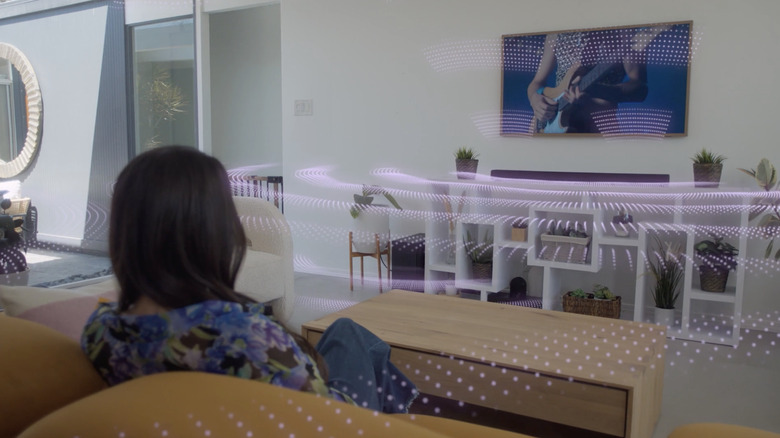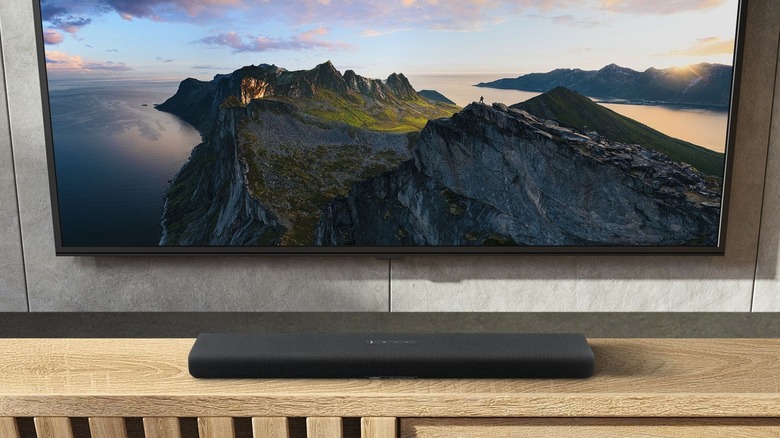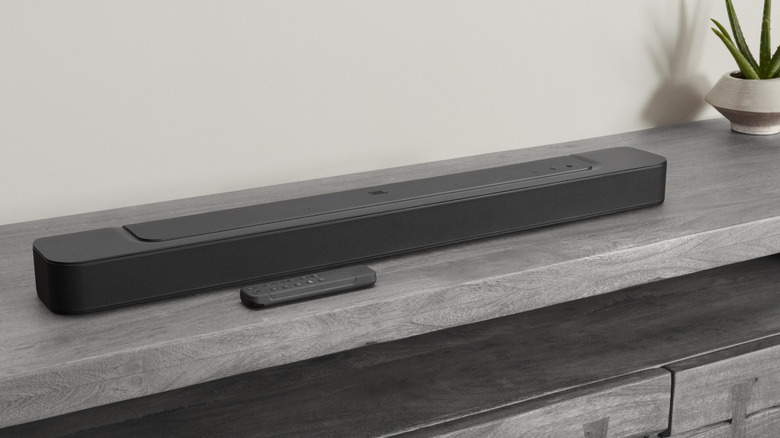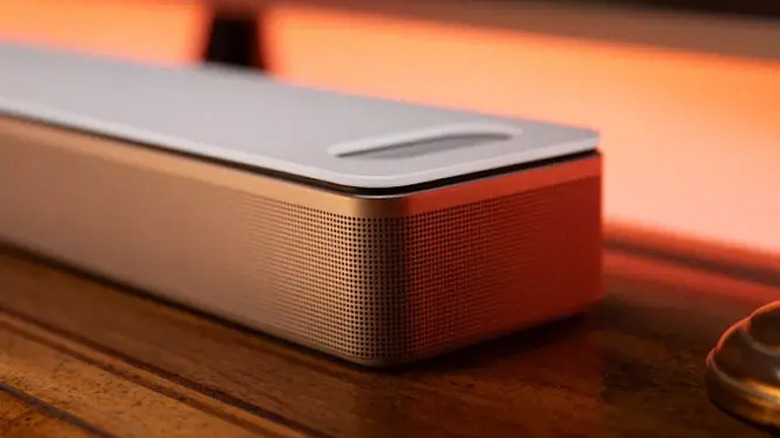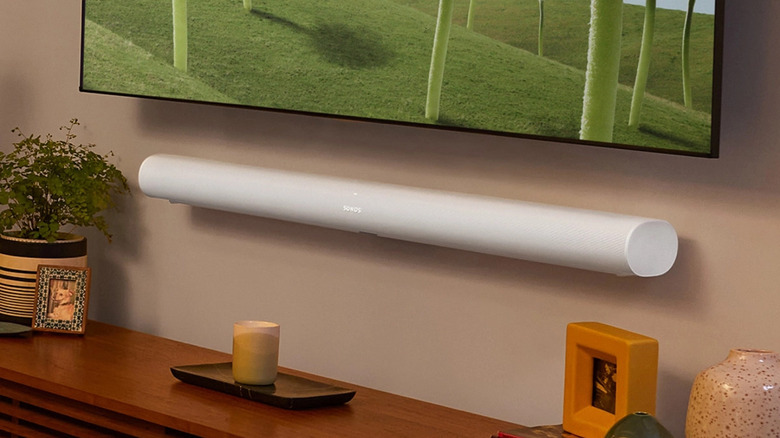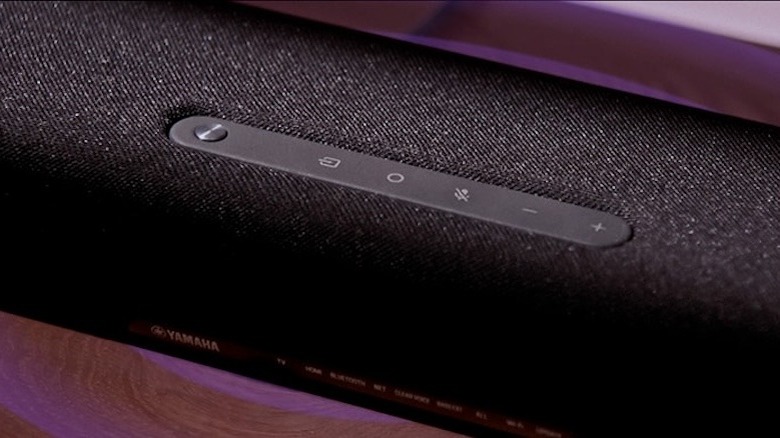Is Yamaha A Good Brand For Soundbars? How It Compares To Brands Like JBL & Bose
The constantly evolving design of televisions over the last decade or so has done wonders for bringing images with exquisite resolution, color, and dynamic range to people's homes. Even if you aren't spending thousands upon thousands of dollars for a brand new 8K television, you are still able to get a very high-quality picture at reasonably affordable prices. It's part of the reason why so many people no longer feel it is necessary to go to a cinema to see a movie.
While the picture options for a television have gotten much better over the years, that has come at the expense of the television's sound quality. Speakers have moved to the backs of TVs, meaning that the sound being projected is moving in the opposite direction from you. This is even worse for televisions mounted to the wall, effectively muffling the sound entirely. It's things like this that have contributed to the rise of people watching subtitles all the time at home, even if they speak the language being spoken.
This is why soundbars are now such a popular speaker option, and many major sound companies out there have made them, like JBL, Bose, and Sonos. Another company that has been in the sound game a long time is Yamaha, and though the company isn't talked about as much in this area, it offers numerous soundbars to deliver you a sound quality to match your TV's picture. Let's break down exactly what kind of soundbars Yamaha has in its stable and see how they compare with these other companies' more famous offerings.
What soundbars Yamaha offers
Currently, Yamaha offers nine different soundbars for purchase. Some of these options are purely just a soundbar, but four of them also come with a separate subwoofer as an included feature. Those nine soundbars can be split into three different categories: True X, SR, and YAS. The True X soundbars are the company's best, most recent, and most expensive additions to its line of soundbars. It currently offers the True X Bar 40A and 50A. These options are outfitted with Dolby Atmos capabilities, built-in Alexa service, and are Bluetooth ready. The difference between them is that the 40A has subwoofers built into the soundbar, whereas the 50A utilizes an external one. In both cases, you are able to connect other wireless speakers to your setup if you want.
Then you have the SR soundbars, which themselves can be broken up into SR-B and SR-C bars. The SR-C bars, the 20A and 30A, are Yamaha's most basic soundbars, simply meant to deliver clear sound. The SR-B bars are a step-up. The B20A delivers DTS virtual 3D sound, and the B30A and 40A models — the latter of which comes with an external subwoofer — up that to Dolby Atmos. These soundbars aren't as big as the True X models and can't connect to other Yamaha speakers for full surround sound.
Lastly, there's the YAS-109 and 209, which sit between the SR-B and SR-C models in both function and price. Both offer DTS virtual 3D audio and support Alexa voice control. It may not be full home theater quality, but it's a big step up from your television's native speakers.
Compared to JBL
Yamaha may be a mainstay of the audio world, but its reach goes far beyond speakers, as the company is more well-known for producing musical instruments, vehicles, and more. Its competitors, however, are often solely known for audio hardware and home entertainment, putting Yamaha at a marketing disadvantage.
Take a company like JBL. Yes, it is probably most associated with its personal, portable Bluetooth speakers, but JBL also offers a plethora of home theater audio options. That range extends from being more budget friendly than the cheapest Yamaha soundbar to setups costing more than twice that of the most expensive Yamaha. When it comes purely to soundbars, JBL currently offers 19 different soundbars of different qualities and sizes, and this includes bundles that feature external subwoofers. JBL also offers several soundbars that come with detachable speakers from the soundbar that allow you to create your own surround sound setup, though you can keep them attached to be purely a soundbar too.
JBL's most basic soundbar is the JBL Cinema SB120, a 2.0 stereo bar that costs $129.95 that is effectively a straight upgrade to TV speakers. However, its options go all the way up to the Bar 1300 X, an 11.1.4 setup with an external subwoofer and detachable side speakers that supports true Dolby Atmos and costs $1,699.95. Between these poles, you will find all kinds of prices and setups. Yamaha's range isn't as large, so it has more limited options.
Compared to Bose
The number of soundbars available from Yamaha is far more comparable to a company like Bose, one of the premiere brands out there creating audio equipment. Effectively, Bose offers three different soundbars. You have the Bose TV Speaker as the budget option, the Smart Soundbar 600 as the mid-tier selection, and the Smart Ultra Soundbar as the top-tier premium bar. Right off the bat, there is a significant difference in price between the Bose and Yamaha. At $279 for the TV Speaker, it's a little tough to call that the "budget option," but compared to the $499 and $899 prices for the Smart Soundbar 600 and Smart Ultra Soundbar, respectively, that's what it is.
Bose does offer subwoofers and other external speakers with its soundbars, but the bundles are not as good of a deal as Yamaha's offerings. The Yamaha SR-B40A costs $399.95, just $120 more than the subwoofer-less SR-B30A. That is not the case with Bose. To use the company's mid-tier comparison, the Smart Soundbar 600 costs $499 on its own, but a bundle with a subwoofer goes for $998. A bundle implies some sort of discount, like a combo meal at a fast food restaurant or purchasing an annual subscription to a streaming service instead of a monthly one, but for Bose, it's more like a quicker way to purchase a group of à la carte items. The quality of the Bose equipment is certainly higher than Yamaha, but it's up to you to decide if the cost is worth that improvement.
Compared to Sonos
Perhaps even more than Bose, the biggest name when it comes to soundbars is Sonos. Even though the company makes other products, Sonos is probably the one that has become synonymous with soundbars and home theater audio equipment. However, its soundbar offerings are pretty much right in line with what Bose has to offer. It similarly features just three different soundbars at low, mid-tier, and premium levels. The base one is the Ray, the mid-tier the Beam, and the Arc as the premium offering. The prices for these soundbars are identical to their counterparts at Bose with the $279, $499, and $899 for each one, making the comparison even more similar.
There are differences between Sonos and Bose when it comes to connectivity and what kind of supplementary external speakers can be attached, but in terms of strict soundbar offerings, the two companies are similar. That means that in relation to Yamaha, it sits as another option that is somewhat more premium than the more modest brand. For example, Sonos has its TruePlay feature, which allows the soundbar to tune itself to the acoustics of the specific room you place it in for the best sound quality possible even on the least expensive Ray soundbar. Yamaha doesn't have a feature like this for its most expensive option, let alone the least. Bose has a similar technology called TrueSpace, but you need at least the mid-tier Smart Soundbar 600 for that. You might think Yamaha has this because of its similarly named True Sound, but that is a separate feature found across all of its products, not room-specific acoustic calibration.
Final conclusions and methodology
If you are looking into soundbars, Yamaha has shown itself to be a very solid option. With features like Dolby Atmos and implementation of Alexa on some of its soundbars, it shows that you don't necessarily have to pay the most premium of prices to get quality audio for your television that probably desperately needs it. The company has also made bundles featuring a soundbar and an accompanying external subwoofer, favorably priced compared to some of its competitors. There are even more budget-friendly options out there, such as JBL, and there are more premium soundbars available as well, such as Bose and Sonos. Yamaha fits perfectly within that mid-tier space. So, it may not make for the best centerpiece of a high-performance home theater, but for the purposes of servicing your average TV watcher, it is more than acceptable. This is evidenced also by the customer reviews for the lower tier Yamaha soundbars like the SR-C and YAS models being higher than the company's premium True X offerings.
For us to determine how Yamaha soundbars fit within the wider soundbar landscape, the most important elements were the actual specifications of the soundbars themselves. This included the price, the sound quality, the features offered, and the optionality that comes with wanting to add additional speakers. We also took customer reviews for the soundbars into account and compared them with soundbars from other companies in a similar price and quality range. For instance, the Yamaha True X Bar 50A has a 3.8-star rating, whereas the Bose Smart Ultra Soundbar has a 4.5. These allow for a head-to-head look at customer satisfaction.
